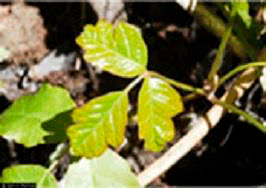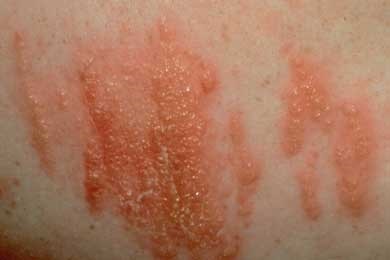Joseph R. Anticaglia MD
Medical Advisory Board
When springtime and summer come our way, thoughts turn to the outdoors. For some, it’s time to plant seeds and tend to the garden. For others, camping trips are the best way to enjoy nature and relax. For landscapers and outdoor workers, it’s the season to plant trees, cut grass, clear and prune shrubbery. But getting too close to nature can often be an intense itching, blistering experience.

Three Leaf Poison Ivy—Photo Courtesy Poison Ivy – Allergic Contact Dermatitis

U.S. Dept. of Agriculture
Exposure to Poison Plants
Poison ivy and poison oak release an oily substance, urushiol when the leaves or other parts of the plant become damaged or burned. If this oily sap contacts the skin, an allergic skin reaction occurs in most individuals.
The oily substance sticks to the skin within minutes after exposure and within 24 to 72 hours symptoms may start to appear. People complain of an itchy rash with bumps or blisters. The degree of severity varies from person to person.
There are other ways people can become exposed to these plants. It’s not recommended to burn the plants. The fumes contain the sensitive oil and if they’re inhaled can cause lung irritation and severe difficulty breathing. Also, indirect contact occurs by touching clothing, boots, tools or animals (dogs, livestock) that have urushiol on them.
People become exposed to urushiol through:
- Direct contact with the plant
- Inhalation
- Indirect contact
Plant Identification
Poison Ivy

Photos courtesy of U.S. Department of Agriculture — Poison Ivy
- Eastern poison ivy typically has three shiny green leaves ( red in the fall) budding from one small stem
- The central leaf is the largest with a distinct stem. The two lower leaflets are smaller and often asymmetrical
- It has a hairy, rope-like vine that’s capable of growing 75 feet.
- Western poison ivy is typically a low shrub with three leaves that does not form a climbing vine
- Every part of the plant is poisonous.
- May have yellow or green flowers and white to green-yellow or amber berries
Poison Oak

Photos courtesy of U.S. Department of Agriculture – Poison Oak
- Typically a shrub with leaves of three
- More common in Western states
- Pacific poison oak may be vine-like
- May have yellow or green flowers and clusters of green-yellow or white berries
- Can be hard to distinguish from poison ivy It’s another poison plant that releases urushiol which is described below
Poison Sumac
It’s another poison plant that releases urushiol which is described below.

Photos courtesy of U.S. Department of Agriculture – Poison sumac
- Grows as a woody shrub
- Each stem contain 7-13 leaves arranged in pairs
- May have glossy, pale yellow, or cream-colored berries
It’s been said that urushiol is as hard to remove from the skin as axle grease! You need to remove the oil as soon as possible after being exposed to it by “scrubbing” the area with a cleanser. Most of the time soap and water and a damp cloth will do. Scrub the area two or three times and a shower is preferable to taking a bath. Wash the garden tools, gloves and anything that has come in contact with these plants.
You might have heard: “Leaves of three, let them be.” It’s a helpful aphorism to identify poison ivy and oak plants, but not sumac. As with all sayings there are exceptions. For instance, the appearance of the leaves varies depending on the species, the location of the plant and the season.
Why not make the effort to recognize and avoid these common, harmful plants to minimize discomfort? Guided wildlife tours are available in many of our communities.
References
National Institute for Occupational Safety and Health – NIOSH; Poisonous Plants, July 7, 2016
New York State; Poison Ivy; Department of Environmental Conservation
U.S. Food and Drug, Outsmarting Poison Ivy and Other Poisonous Plants, Nov. 7, 2017
Richard, P et al; Diagnosis and Treatment of Contact Dermatitis; American Fam Physician, Aug, 2010
Glossary
Poison Ivy (Toxicodendron radicans) is a native plant to North America Urushiol — (you-ROO-she-all),
This article is intended solely as a learning experience. Please consult your physician for diagnostic and treatment options.

